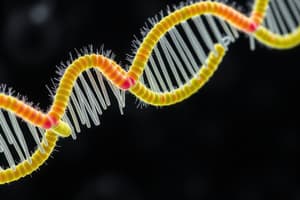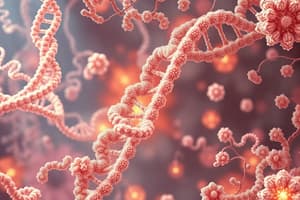Podcast
Questions and Answers
During transcription, what is the function of RNA polymerase?
During transcription, what is the function of RNA polymerase?
- Synthesize an RNA version of the instructions stored in DNA (correct)
- Match complementary bases to both strands of DNA
- Promote the synthesis of DNA from an RNA template
- Serve as a structural component of the ribosome
Which strand of DNA is used as the template during transcription?
Which strand of DNA is used as the template during transcription?
- The non-template, or coding strand
- One strand of DNA, known as the template strand (correct)
- The strand with the highest GC content
- Both strands of DNA simultaneously
What type of nucleotides does RNA polymerase use during transcription?
What type of nucleotides does RNA polymerase use during transcription?
- Deoxyribonucleoside monophosphates (dNMPs)
- Ribonucleoside triphosphates (NTPs) (correct)
- Ribonucleoside monophosphates (NMPs)
- Deoxyribonucleoside triphosphates (dNTPs)
What is the role of the non-template (coding) strand during transcription?
What is the role of the non-template (coding) strand during transcription?
In bacteria, how many RNA polymerases are involved in transcription?
In bacteria, how many RNA polymerases are involved in transcription?
What is a characteristic feature of eukaryotic transcription start sites?
What is a characteristic feature of eukaryotic transcription start sites?
Which organism's RNA processing is more extensive?
Which organism's RNA processing is more extensive?
How does translation initiation and termination complexity compare between bacteria and eukaryotes?
How does translation initiation and termination complexity compare between bacteria and eukaryotes?
What did Crick propose regarding the interaction between mRNA codons and amino acids?
What did Crick propose regarding the interaction between mRNA codons and amino acids?
How are amino acids transferred from tRNAs to polypeptides?
How are amino acids transferred from tRNAs to polypeptides?
In eukaryotes, how many general transcription factors are involved in transcription?
In eukaryotes, how many general transcription factors are involved in transcription?
What is a characteristic feature of bacterial promoter structure?
What is a characteristic feature of bacterial promoter structure?
What is the role of the Shine–Dalgarno sequence in translation initiation in bacteria?
What is the role of the Shine–Dalgarno sequence in translation initiation in bacteria?
What does the initiator tRNA carry in bacteria during translation initiation?
What does the initiator tRNA carry in bacteria during translation initiation?
What occurs at the start of elongation in translation?
What occurs at the start of elongation in translation?
What is the composition of the ribosome's active site where peptide bond formation occurs?
What is the composition of the ribosome's active site where peptide bond formation occurs?
When does translocation occur in the ribosome?
When does translocation occur in the ribosome?
What happens during translocation in the ribosome?
What happens during translocation in the ribosome?
What triggers the termination of translation?
What triggers the termination of translation?
What is the next step after the arrival of aminoacyl tRNA during translocation?
What is the next step after the arrival of aminoacyl tRNA during translocation?
What occurs at the start of translation initiation in bacteria?
What occurs at the start of translation initiation in bacteria?
What happens to most proteins before they become functional?
What happens to most proteins before they become functional?
What is crucial for determining a protein's function?
What is crucial for determining a protein's function?
Where does the ribosome move during translocation in translation?
Where does the ribosome move during translocation in translation?
Which direction does RNA polymerase perform template-directed synthesis?
Which direction does RNA polymerase perform template-directed synthesis?
What is the length of bacterial promoters?
What is the length of bacterial promoters?
What is the function of sigma protein in bacterial transcription initiation?
What is the function of sigma protein in bacterial transcription initiation?
How does termination occur in bacterial transcription?
How does termination occur in bacterial transcription?
What distinguishes eukaryotic transcription from bacterial transcription?
What distinguishes eukaryotic transcription from bacterial transcription?
What is the role of spliceosomes in eukaryotic transcription?
What is the role of spliceosomes in eukaryotic transcription?
How many distinct types of RNA polymerases do eukaryotes have?
How many distinct types of RNA polymerases do eukaryotes have?
What is the function of the holoenzyme in bacterial transcription initiation?
What is the function of the holoenzyme in bacterial transcription initiation?
What is the sequence of the −10 box in bacterial promoters?
What is the sequence of the −10 box in bacterial promoters?
What is the sequence of the −35 box in bacterial promoters?
What is the sequence of the −35 box in bacterial promoters?
What occurs during elongation in bacterial transcription?
What occurs during elongation in bacterial transcription?
What was revealed by the discovery of split eukaryotic genes in 1977?
What was revealed by the discovery of split eukaryotic genes in 1977?
What is the function of adding a 5' cap and a poly(A) tail to pre-mRNAs?
What is the function of adding a 5' cap and a poly(A) tail to pre-mRNAs?
Where are untranslated regions (UTRs) found in mature mRNAs?
Where are untranslated regions (UTRs) found in mature mRNAs?
What is the role of transfer RNA (tRNA) in translation?
What is the role of transfer RNA (tRNA) in translation?
How are amino acids attached to tRNA?
How are amino acids attached to tRNA?
What allows tRNAs to read the 61 different codons?
What allows tRNAs to read the 61 different codons?
Where do tRNAs fit into during translation in the ribosome?
Where do tRNAs fit into during translation in the ribosome?
What is the site of protein synthesis according to the pulse-chase experiment by Britten and colleagues?
What is the site of protein synthesis according to the pulse-chase experiment by Britten and colleagues?
In bacteria, when can ribosomes begin translating an mRNA?
In bacteria, when can ribosomes begin translating an mRNA?
How are transcription and translation related in eukaryotes?
How are transcription and translation related in eukaryotes?
What is the role of the small subunit of ribosomes during translation?
What is the role of the small subunit of ribosomes during translation?
How many tRNAs are there in most cells?
How many tRNAs are there in most cells?
What is the length of transfer RNA (tRNA)?
What is the length of transfer RNA (tRNA)?
Flashcards are hidden until you start studying
Study Notes
Overview of Transcription and Translation Processes
- Pre-mRNAs undergo processing which includes adding a 5' cap and a poly(A) tail to protect against degradation and enable translation.
- Mature mRNAs contain untranslated regions (UTRs) at both ends.
- Translation is a complex process involving ribosomes, mRNA, and tRNAs.
- A pulse-chase experiment by Britten and colleagues showed that ribosomes are the site of protein synthesis, where proteins are synthesized and then released.
- In bacteria, ribosomes can begin translating an mRNA before transcription is complete, forming a polyribosome and producing many copies of a protein from one mRNA.
- In eukaryotes, transcription and translation are separated, with mature mRNAs being transported to the cytoplasm for translation by ribosomes and polyribosomes.
- Transfer RNA (tRNA) is used as the adapter molecule in translation, linking amino acids to the growing polypeptide.
- tRNAs are relatively short, 75-95 nucleotides long, and contain a CCA sequence at the 3' end as the amino acid binding site and an anticodon for mRNA codon binding.
- Amino acids are attached to tRNA with the help of aminoacyl-tRNA synthetases, with each amino acid having a specific synthetase.
- There are about 40 tRNAs in most cells, which can read the 61 different codons through wobble pairing in the anticodon's third position.
- Ribosomes, containing proteins and ribosomal RNA (rRNA), have a small subunit that holds mRNA and a large subunit where peptide bonds form during translation.
- During translation, tRNAs fit into three sites in the ribosome: A site (acceptor or aminoacyl), P site (peptidyl), and E site (exit) where tRNAs without amino acids exit the ribosome.
Studying That Suits You
Use AI to generate personalized quizzes and flashcards to suit your learning preferences.




